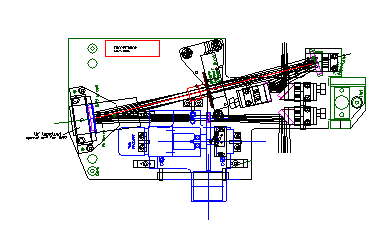OSL
Optical Science
Laboratory
Intro
Science
Optical design
Mech Design
Team

O
ptimised Stellar Coronograph for Adaptive OpticsMechanical Design

Figure 1 Schematic of the mechanical design of OSCA
The system will consist of the following components
1) Deployment Stage
The whole OSCA system will be deployed in and out of the NAOMI beam by a pneumatic pistin system controlled by a solenoid valve. The final positioning is provided by a manually adjusted hard stop. Position/status feed back is provided by 2 limit microswitches.
2) Top plate
The OSCA top plate will be mounted on a kinematic 3 point push/pull system. Kinematics give 2 axis rotations plus piston. Third rotation will be by adjustable screw system on one of the three points.
3) Steering mirror supports
The mirrors will be mounted on top-adjust XY commercial mounts to provide tip/tilt motion of the mirrors. These mounts will be capable of being moved along the incoming beam by a manual screw adjustment
4) Collimating Mirror supports
The collimating paraboloids will be mounted on commercial mirror mounts. The first paraboloid will be mounted on a manually back-adjusted mount with three screws allowing tip/tilt and piston positioning. Height adjustments will be provided by a 3 point screw system The second paraboloid will be mounted on a top adjusted XY mount and because it has no height adjustment it will define the height of the system above the top plate.
5) Focal Plane Mask Assembly
This is one of the most critical components, as the focal plane masks have to be located at the focal plane with a positional repeatability of <10microns. This tolerance is governed by the fact that the decentering error of the star image on the centre of the focal plane mask should be less than 10% in order that the performance is not significantly degraded. As the smallest size focal plane stop is ~90 microns this gives us our tolerance on positioning.
It is planned that a selection of stop sizes will be available on a remotely selectable wheel. The focal masks themselves will be produced using standard contact photolithography technique. Gaussian edged stops will be produced by defocusing the production mask on the substrate by introducing a gap between production mask and the substrate.
These focal plane stops will be mounted on thin (3mm) substrates (IR grade fused silica) that would have a wedge angle of ~1 degree to remove ghosting effects.
Control of the wheel movement is by a stepper motor. The absolute positioning of each aperture mask is by the action of a pneumatic detent mechanism which will lock into a v-shaped grove on the edge of the wheel. Position and status feedback is by an incremental encoder and home switch.
Positioning of the focal plane masks will be by closed loop operation using the encoder feedback. When in nominal position the stepper motor is switched off and the detent mechanism positions the mask to the required accuracy.
The focal mask wheel will be mounted on an XY stage with a screw mechanism to provide focal adjustment.
6) Lyot stop assembly
The Lyot stop assembly will consist of a commercial rotation stage unit. This is a stepper motor driven system incorporating a home switch. The accuracy that the Lyot stop can be positioned is 0.06 degrees, whilst the smallest step size is 0.006 degrees.
Mounted on the rotation stage will be the Lyot mask. This will be etched aperture mask that will be situated at the conjugate pupil position. This will be located on extension tube attached to the rotation stage.
The Lyot stop must rotate so as to keep alignment between the secondary and tertiary mirror struts and the masking vanes in the Lyot stop in order to eliminate the central star light that arises along these strut edges in the pupil plane. The positioning of the Lyot mask will be achieved by step counting from the fiducial position.
It is envisaged that the Lyot size stop will not be remotely changeable but different size stops will be available that will be interchanged manually.
The Lyot rotation stage itself will be mounted on a 3 point lockable support to allow
As there is no status or positional feedback system in the Lyot rotation stage, the following method of system check is proposed. On deployment the Lyot stop will rotate round to the home position, then away by a fixed number of counts and then back again to check that the motor is moving.
The rate of rotation w of the Nasymth derotator is determined by the RA and DEC of the object being observed, the rate being given by the equation:-
![]() ,
,
where t is the sidereal time and T the sidereal day. The component the Lyot stop must remove is the first part of this equation.

7) Pre-NAOMI focal plane Assembly
A pre-NAOMI focal plane dichroic stop will be provided to suppress stray light when the NAOMI is being used in a partial correction mode. The size of the stop is limited by the seeing disk to a size of 0.7 arcseconds (close to the median seeing conditions) would be appropriate. The stop itself will be small dichroic disk on a larger substrate. The dichroic should match the transmission/reflection properties of the appropriately selected dichroic in the universal port though due to cost constraint only one or two masks can be provided.
Space constraints at the pre-NAOMI focus mean the stop can not be easily positioned with a remotely operated drive, and the position is also used for the artificial star system in NAOMI. It is therefore proposed to use the same system of kinetic mounting as used by NAOMI for placement of the focal plane dichroic stop. This kinetic mount can reposition to a few microns, though the required accuracy on positioning the dichroic spot is of the order of 20 microns (10% of disk size).